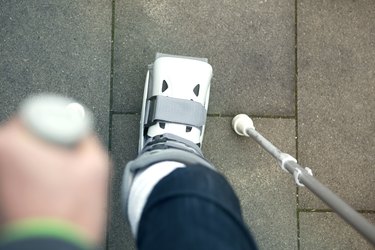
Whether you fell off a ladder or were injured playing sports, walking on a broken foot too soon can set back healing time and cause more injury. Before you ditch the crutches or walking boot, understand how bones heal and the importance of proper weight bearing on your foot for optimal recovery.
Tip
Most foot fractures will allow you to be fully weight bearing, as long as you are in a walking boot or cast. If your injury is in your heel or fifth metatarsal, however, expect to be non-weight bearing for six to eight weeks.
Video of the Day
Broken Foot Healing Time Stages
Treating a broken foot isn't always an exact science, which is why it's important to have a doctor evaluate your injury. There are several factors that affect healing time; however, a broken bone, in general, takes six to 12 weeks to heal. Younger kids and healthy adults heal more quickly, while older adults or those with pre-existing conditions may take longer to get better.
Video of the Day
The location of the fracture also significantly affects healing time and determines if you wear a cast vs a boot for your broken foot. The American Academy of Family Physicians provides guidelines on healing time and weight bearing, depending on the location of the injury. If your broken bone is displaced and requires surgery or pins to help stabilize it, the healing time will be longer than a bone that is not displaced and requires no surgery.
Weight-Bearing Rules for Toes
If you drop something on your big toe or stub it on the sofa and break it, you may be surprised to find that you will need a cast or walking boot. The big toe plays a big role in balance and maintaining a normal walking pattern; therefore, it is important that it heals correctly. You can expect to be in a short walking boot or cast with a supportive toe plate for two to three weeks, followed by a rigid sole shoe for three to four weeks.
The good news is you can have full weight bearing, as long as you have it supported. After the boot is removed, you will work on regaining strength and mobility.
If you luck out (if you want to call it that!) and just break your smaller toes, the treatment is much easier. You will have full weight bearing and normal activity as tolerated. Treatment requires only buddy taping your toes together to provide support, along with wearing supportive, rigid sole shoes for four to six weeks.
Read more: Broken Little Toe and Running
Weight-Bearing Rules for Metatarsals
The metatarsals are those long bones in your foot between your toes and ankle. A metatarsal fracture is often caused by an overuse injury and results in pain in the middle of your foot. This injury often causes a stress fracture and requires a short leg walking boot or a cast for up to six weeks; however your doctor will often have you follow up every two weeks to monitor healing.
You will have full weight bearing in the boot or cast. After the walking boot is removed, you will do exercises to work on regaining strength, balance and flexibility.
The only exception to this rule is if you break your 5th metatarsal, which is the bone that connects to your pinky toe. This injury, called a Jones fracture, causes pain and swelling on the outside of your foot and is often seen in athletes and dancers.
Traditional treatment of a fifth metatarsal fracture is much more extensive and usually requires a cast and no weight bearing for six to eight weeks. After the cast is removed, you will progress to partial or weight bearing as tolerated, and then you will start to work on regaining strength and mobility.
A study published in the September 2016 issue of the Journal of Foot and Ankle Surgery is changing the way the Jones fracture is treated, as it shows that earlier weight bearing in a walking boot resulted in better bone healing than extended non-weight bearing.
Read more: Exercises After a Metatarsal Fracture
What About a Broken Heel?
A heel or calcaneus fracture is often the result of a fall, such as falling off of a ladder, or a car accident. The American Academy of Orthopaedic Surgeons recommends a cast and non-weight bearing for six to eight weeks, followed by partial weight bearing for up to 10 weeks, before a gradual return to full weight bearing.
For those that have an injury requiring an extended period of non-weight bearing, such as the heel fracture, using a knee scooter can make it easier to get around than crutches.
Read more: The Best Cardio Exercise for a Foot Injury
Cast Versus Walking Boot
Your doctor's decision to put you in a cast versus a boot for a broken foot has to do with how much stabilization your injury requires to prevent you from walking on a broken foot too soon. More serious injuries, including those that need surgery or a broken heel bone, require the bone to be completely immobilized for proper healing, while less serious injuries, such as a big toe fracture, should heal just fine in a walking boot.
- American College of Foot and Ankle Surgeons: "Bone Healing: How Does a Bone Heal?"
- American Academy of Family Physicians: "Diagnosis and Management of Common Foot Fractures"
- U.S. National Library of Medicine: "Metatarsal Fracture: Acute Care"
- Journal of Foot and Ankle Surgery: "Treatment of Acute Jones Fractures Without Weightbearing Restrictions"
- American Academy of Orthopedic Surgeons: "Calcaneus Fractures"